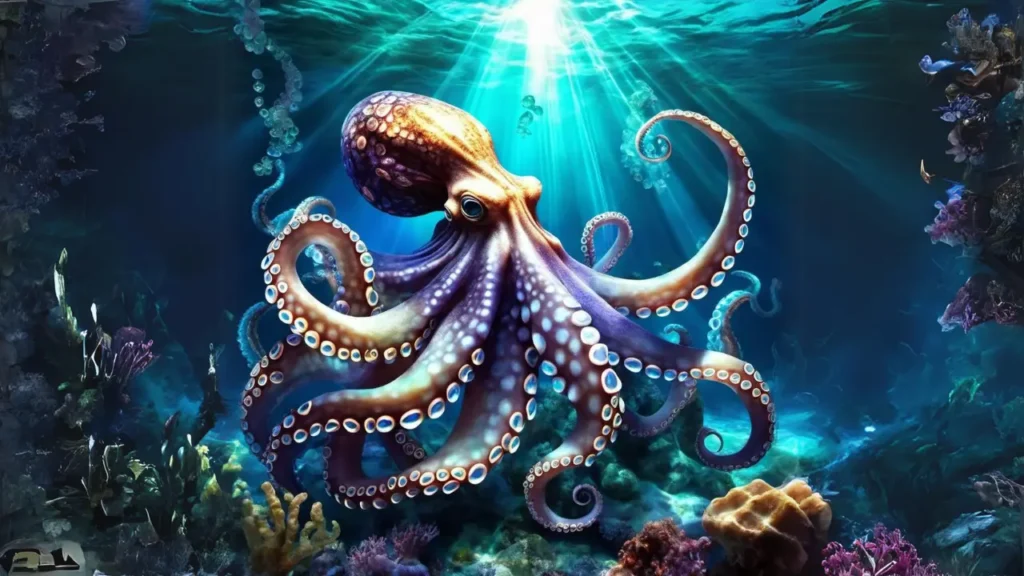
Octopuses boast an intriguing circulatory system equipped with three hearts, a feature intricately tied to their possession of blue blood. In this fascinating anatomical setup, two peripheral hearts facilitate blood pumping through the gills, where it undergoes oxygenation. Subsequently, a central heart ensures the distribution of oxygen-enriched blood throughout the organism, supplying energy to various organs and muscles.
The Blue Blood Connection in octopus
Cephalopods, a term translating to “head foot,” octopuses share this unique trait with their cephalopod counterparts – squids, cuttlefish, and nautiluses. Their blood’s distinctive blue hue arises from using a copper-rich protein known as haemocyanin for oxygen transportation. This specific choice of proteins clarifies the necessity for three hearts in octopuses.
While our red blood relies on the iron-based protein haemoglobin carried within red blood cells, cephalopods employ the larger haemocyanin circulating in the blood plasma. Despite haemocyanin’s comparatively lower oxygen binding efficiency, octopuses compensate for this limitation with their tripartite cardiovascular system.
The Three-Heart Mechanism
Octopuses possess two “branchial” hearts responsible for receiving deoxygenated blood from various body parts and pumping it through the gills. Additionally, a “systemic” heart receives the oxygen-rich blood, increases its pressure, and circulates it to the rest of the body. This intricate system enables octopuses to efficiently oxygenate their extensive nervous system, a crucial requirement given their active lifestyle.
Navigating Their Environment
Octopuses, characterized by their nine brains, one central and eight mini-brains in each arm, need oxygenated blood to sustain their energetically demanding neural tissue. Their preferred modes of locomotion include crawling along the seabed and swimming at high speeds propelled by jets of water expelled through a siphon. Notably, the systemic heart ceases to beat during swimming, increasing fatigue.
Adaptability and Challenges
With approximately 300 species, ranging from the giant Pacific octopus to the diminutive Octopus wolfi, these solitary creatures inhabit diverse environments, from intertidal zones to deep waters. The advantage of having blue blood becomes evident in its ability to efficiently transport oxygen in environments with varying temperatures and oxygen levels. However, the impact of climate change poses a challenge, as haemocyanin loses its oxygen-binding capacity with increasing acidity, potentially endangering octopuses in warmer and more acidic oceans.
READ MORE: Why do flamingos stand on one leg?
Why do octopuses have nine hearts?
Octopuses do not have nine hearts; they have three. The misconception may arise from their complex circulatory system, which includes two “branchial” hearts and one “systemic” heart. This tripartite design efficiently pumps blood and oxygen throughout the octopus’s body, supporting its active lifestyle and extensive nervous system.
Why do squids have three hearts?
Similar to octopuses, squids possess a three-heart system. This adaptation is crucial for efficiently oxygenating their blood, as they, too, are cephalopods. The three hearts work collaboratively to pump blood through the gills for oxygenation and distribute it to various body parts, contributing to their adaptability in underwater environments.
What animals have more than one heart?
While octopuses and squids are notable examples of three hearts, some earthworms have five pairs of hearts distributed along their body segments. Additionally, certain species of cockroaches possess multiple hearts, providing redundancy in their circulatory systems. The presence of more than one heart can vary across different animal species.
Why is octopus blood blue?
Octopus blood is blue due to the presence of the copper-based protein haemocyanin. Unlike the iron-based haemoglobin found in vertebrates, haemocyanin efficiently transports oxygen in the blood plasma of cephalopods. This unique adaptation gives octopus blood its distinctive blue colour and helps them efficiently oxygenate their bodies, particularly in diverse oceanic environments.